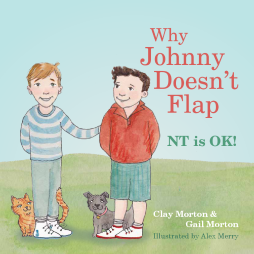
Additional Information
Book Details
Abstract
Johnny is different. He is never exactly on time, he can't seem to stick to a routine and he often speaks in cryptic idioms. Johnny is neurotypical, but that's ok.
A picture book with a difference, Why Johnny Doesn't Flap turns the tables on common depictions of neurological difference by drolly revealing how people who are not on the autistic spectrum are perceived by those who are. The autistic narrator's bafflement at his neurotypical friend's quirks shows that 'normal' is simply a matter of perspective.
Clay Morton is Associate Professor of English and Director of the Honors Program at Middle Georgia State University. Gail Morton (MLIS) is a Public Services Librarian at Mercer University. Clay and Gail research issues of neurodiversity, particularly in relation to higher education. They are parents to a child with autism and are both advocates for the neurodiversity movement.
This is a wonderful wheeze! Johnny is neuro-typical, while the story teller is autistic. We see Johnny from his point of view, and to him, Johnny is a cause of bafflement... However, our narrator says his mum explains that everyone is different, and just because Johnny is different doesn't mean they can't be good friends. Which they are... The funny and clever thing about this approach is that the narrator seems to feel slightly superior to Johnny, and it is interesting and possibly unique in a picture book to show how autistic people look at those of us who don't share their outlook. A brilliant and highly original book with lovely warm illustrations.
Healthy Books
healthybooks.org.uk
A delightful departure from the norm, Why Johnny Doesn't Flap flips the script and models empathy, acceptance, and compassion for that oddest of neurologies, the neurotypical. This irreverent subversion is a breath of fresh air, and reminds us that there's not a right way to have a brain, and that 'normal' is in the eye of the beholder. We're better off with a dose of the Mortons' wry perspective.
Julia Bascom, author, The Obsessive Joy of Autism
An unnamed boy with autism describes his friend Johnny's unusual and sometimes perplexing behaviors: "Mom says it is because he is NT, or neurotypical. He doesn't have autism, so his brain works differently from mine, but that's ok." Johnny doesn't arrive precisely on time to visit, makes direct eye contact, "doesn't have a topic he knows everything about, like World War II or dinosaurs or forklifts," and "always wants to play with other kids." Merry's artwork is somewhat rudimentary (the boys' facial expressions scarcely change, even when the narrator is having a "meltdown," and there isn't much variation in the staging of the images). But the authors' subversion of expectations through the narration is effective and thought-provoking, and may well lead neurotypical readers to reconsider their own behaviors and judgments. Ages 5-9. (Oct.)
Publishers Weekly
The young narrator of this charming book helps readers understand why a neurotypical peer's behavior can be so confusing. Fun illustrations support the text, providing extra opportunities for discussion exploring the differences between NT and ASD behaviors, and that's more than OK. That's super duper!
Liane Holliday Willey, author of Pretending to be Normal, Asperger Syndrome in Adolescents, and Asperger Syndrome in the Family
A young narrator explains that his neurotypical friend is OK, even though he sometimes plays games out of order and doesn't flap his hands to express emotions. It's a neat bit of role reversal. It's really OK that Johnny arrives for playdates a few minutes late or early ("hopeless when it comes to punctuality"), that his gaze is direct, that he really doesn't seem interested in knowing everything about hydraulic forklifts, wants to play with other kids ("Maybe he's a little too obsessed with social interaction"), and never has a meltdown when there's a fire drill at school. "Mom says that everyone's brain is different, and different isn't always wrong." A closing note for parents offers further bids for acceptance: "as many as 67 in 68 children may be neurotypical. So if your child does not currently have an NT kid in their life, they almost certainly will." Merry's stripped-down, neatly drawn generic views of dewy-eyed figures with fixed, tight-lipped smiles neither give the characters any individuality nor do the premise's ingenuity much service, though they are doubtless calculated to make it easy for the book's autistic readers to decode. It looks bland at first, but it's a clever perspective changer for NT children as well as a rare chance for young readers with autism to see themselves as a point-of-view character. (Picture book. 6-8)
Kirkus Reviews
